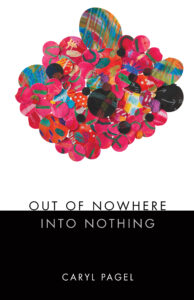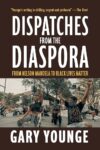
[University of Alabama Press; 2020]
On the road and, for a few hours, 80 West still feels like Colorado, the front range blending with Wyoming’s Archean rock — deep green memory of great lakes guides cars and errant horses. Entering Utah, Park City, feels just like the western Rockies dotted in evergreens and vibrant mountain living. For a moment, I wonder if the endless highway is actually a spiral. A few hours pass and suddenly the freeway rises and falls at the base of Salt Lake; it is the kind of abrupt sprawling encounter that takes your breath away. The same could be said for the fragments encountered in Caryl Pagel’s Out of Nowhere into Nothing. Like the energy of Utah’s terminal lake, these essays induce awe, revelation, oneness, and nothingness, often all at once, as Pagel confronts the paradox of life and death on round-about roads rising and falling through landscapes: Iowa City, Chicago, Copenhagen, Libertyville, Wisconsin, Prague, Salt Lake.
Pagel’s collection of 10 braided essays tour the personal, the grotesque, the uncanny, and peculiar — a constant reminder of our attachment to the invisible. Billed as a “radical retelling of loneliness,” I would argue Pagel excavates maps of our interconnected nature and proclivity to connect the seemingly unrelated in an attempt to understand human experience. The collection’s title essay explores the mirror neuron, the neurons of empathy, which allow an observer or listener to viscerally experience what they are told “by feeling”, not thinking. As a poet, the mirror neuron is central to Pagel’s artistry. As an essayist, her form, often fragments guided by a black dot between thoughts, allows for the implicit to work magic upon a reader’s thoughts drawing unspoken constellations. The mirror neuron is perhaps the greatest metaphor for Pagel’s debut essay collection, causing readers to squirm at the corneal incision in “Driving at Night: A Chorus”, enrage when they learn the coach’s blood was ketchup in “A Pickle for the Knowing Ones”, and enter reverence at the awareness of humanity’s uncertain future throughout the text.
This collection is what I would expect from a founder of Rescue Press: investigative, cross genre, with a subtext centered on transformation. Pages dotted in bite-sized black and white photos ask the reader to hold the book to their nose, to enter and really see, rather than just look. A meditative form of documentary, the sparseness of photos is a reprieve from the daily inundation of stimuli in an image obsessed society. Each photo creates a spiral, building, mirroring, and flowing to the next phrase and block of text. But rather than a mere spiral, the text becomes a labyrinth; a reader enters each essay and comes out different. “Hypnotism,” she writes, “both invoked and symbolized by a spiral, was once thought to censor one’s memory of the very experience of being hypnotized.” Unlike hypnotism, a reader exits Out of Nowhere into Nothing with a distinct memory of experience and renewed interest in investigating the mundane. Yet, there remains something — an essence perhaps — I cannot seem to name.
On Pagel’s website, a visitor can expect to meet a spread of 8 black and white 2×2” square photos: a single duck in a lake of swans, a burger missing two bites, a cityscape, the underside of balloons, the open road, a masked woman, the blur of a woman on a merry-go-round, and the vast expanse of Salt Lake’s Spiral Jetty. “The morning I saw Spiral Jetty,” writes Pagel in Out of Nowhere into Nothing, “under a scorching sun which illuminated the iridescent salt-sand crystals in such a way as to evoke an ice-scape (“ice ages exist, ice ages exist”) instead of reflecting on the record-breaking heat wave that had ignited fires up and down the parks and forest of the west coast — it was easy to imagine how Smithson could have entertained such a hallucination in this location.” In a book based on feeling and the mirroring of experience, perhaps her photos say it best: form cannot be limited to words, or even bodies. To some degree, the personal in this collection is always an arm’s length away, like a photograph without words. Most often names are reduced to a first initial, another clue for holding space for anonymity. In some ways this makes the stories of those fully named — the aforementioned football coach, for example — hold an importance over Pagel’s personal life. Their stories intersect the mundane of daily living, which as each essay shows, turns out to not be mundane at all.
Like Pagel’s poetry, this essay collection circles ghosts, apparitions, and encounters with the unseen. As a text that asks readers to investigate, look closely — to watch the face of a woman, whether she is the statuesque Marina Abramović, or a woman on the street — Pagel prepares us for our own investigative journalism. She asks us to see beyond physical sight. As in Driving at Night: A Chorus, we learn the visceral details of just what it takes to regain eyesight through cataract surgery. There is however, a ghost I cannot quite place my finger on as I flip through these essays. Perhaps the epigraph provides a clue: “A woman must continually see herself—” from John Berger’s Ways of Seeing. A reader can’t help but wonder if this text is a mirror to the unseen woman, or the woman in need of seeing herself. Amidst mirror neurons, Pagel retells The Triumph of the Egg, the story of an old Polish woman fighting a German soldier as a group of refugees were marched into war-torn territory. The spirit of the woman leaves her body and switches places with the German’s. In a Freaky Friday moment the German in the old woman’s body commands the refugees to continue marching to their death. I cannot stop thinking about this story as Pagel asks, “do we turn to art for catharsis?” I wonder if Pagel turns to art, investigation, and the unseen to reckon with what it means to live in a body, particularly the body of a woman. One of this collection’s subtle strengths is the slow encounter of women learning to see themselves and one another in a culture which may see through them, or as some preconceived thing. While so much in Out of Nowhere into Nothing remains as questions and unseen, a collection of curiosity and ellipses, Pagel helps readers transform sight and question into feeling. The title essay ends: “I haven’t stopped feeling for a fictional old woman and have thought about little else.”
In the case of this text, I find the opposite to be true — I’ve thought of so many things, so many peculiarities, investigations, and ways of seeing within the four corners of text, image, and road markers of this book; each thought a sink hole into another apparition. This, to me, seems a natural process for research, reading, and writing; a path which creates circles that intersect and circle upon themselves: a nonlinear path to research and investigatory poetics. One of Pagel’s greatest gifts to readers is the way she maps nonlinear paths to personal and journalistic research. Her circular, errant, and sometimes what at first seem like erratic roads, in the end connect each personal anecdote, peculiar event, and natural wonder, like a series of carefully placed stones. Touching on details that may seem so mundane, she reminds us that the mundane moments are worth recording, charting, and remembering because we cannot forecast where they will lead. Pagel recreates the Spiral Jetty throughout Out of Nowhere into Nothing. An unexpected meditation, each thought is a rock connecting to the next, creating a work of human hand and beyond. May Pagel’s path be one that readers follow, dropping their pins on the map, intersecting, branching.
Amy holds an MFA from the Jack Kerouac School of Disembodied Poetics where she founded Wisdom Body Collective. She is an editor of More Revolutionary Letters: A Tribute to Diane di Prima. Her work can be read/is forthcoming in Entropy, Vol1 Brooklyn, Denver Quarterly, TYPO, and elsewhere. @amybobeda on twitter.
This post may contain affiliate links.







